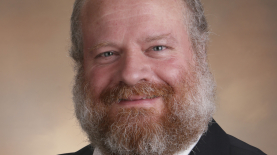
York Dobyns was a long-term member of the research team at the Princeton Engineering Anomalies Research (PEAR) laboratory and continues to publish in parapsychology.
Life and Career
York Dobyns was born in 1960 to anthropologists Henry Dobyns and Cara Richards. He obtained a degree from Ohio State University in 1982, and a Masters in physics and PhD in theoretical physics from Princeton University in 1985 and 1987, respectively. He joined the PEAR Lab as post-doctoral researcher in 1987 and spent almost twenty years working in its programme under Robert Jahn and Brenda Dunne.
Dobyns has been an active member and elective councillor of the Society for Scientific Exploration since 1992. He is currently a database analyst at the University of Kentucky’s cancer registry but has continued to publish in parapsychology, on the subjects of theoretical development, cosmology and zero-point energy.
PEAR
Signature experiments carried out by Dobyns as part of the PEAR programme are described below.
Mega REG
In a 2004 publication, Dobyns and the PEAR team probed the extent to which the number of bits per trial might influence the strength of a psychokinetic (PK) effect. A typical one-second trial being composed of 200 bits, it was expected that using huge numbers of bits would boost PK scoring. However, against expectation, the high-density data (2,000,000 bits per trial) exhibited a significant reversal of intentional effects, with operators scoring below chance expectation (p = 0.022). But the study revealed a hitherto unacknowledged influence of operator experiences in a complex relationship with data densities. New operators demonstrated a significant effect favouring intention in the low-density data (200 bits per trial, p = 0.017), while experienced operators showed a significant deviation in high-density performance (p = 0.001).1
Community Psychokinesis
From the mid-1990s, parapsychologists used random number generators in community settings (such as football matches, concerts and religious festivals) to detect possible PK effects (termed ‘Field-RNG’ testing’). The hypothesis was that the machines, set to run in environments in which intense subjective resonance was evoked, would exhibit greater deviations from chance expectation than those placed in ordinary settings. An early report describes 61 subsequent FieldREG applications of which 40 were exploratory and 21 were hypothesis-driven replications. Analysis of the latter revealed an overall probability of 2.2×10-6 for resonant cases, compared to 0.91 for mundane instances, providing strong evidence for the existence of a field-like PK effect operating in emotional environs.2
Post-PEAR
After the closure of the PEAR Lab in 2007, Dobyns continued to work at Princeton University’s Engineering department until 2012 as a professional optimization specialist, before moving to the University of Kentucky.
Retrocausation
In a 2011 publication, Dobyns discusses the concept of retrocausation, in which events influence their own past. Complications of retrocausation are time paradoxes – also known as Bilking paradoxes - in which something happens only if it does not happen, for example, a scenario in which a person constructs a time machine from plans that were received from an unknown person years before. The person realizes that the stranger was herself, using the time machine to travel back and give the plans to her younger self. A bilking paradox would occur if the woman built the machine, tested its reliability, and then refused to give herself the plans. Dobyns also discusses the work of Daryl Bem in relation to retrocausation.3
Michael Duggan
Literature
Dobyns, Y.H., Dunne, B.J., Jahn, R.G., & Nelson, R.D. (2004). The MegaREG experiment: Replication and interpretation. Journal of Scientific Exploration 18/3, 369-97.
Dobyns, Y.H. (2011). Retrocausation, consistency, and the bilking paradox. AIP Conference Proceedings. 1408.
Dunne, B.J., Dobyns, Y.H., & Intner, S.M. (1989). Precognitive remote perception, III: Complete binary database with analytical refinements. PEAR Technical Report 89002, Princeton Engineering Anomalies Research, Princeton Univ. School of Engineering/Applied Science.
Jahn, R.G., Dunne, B.J., Nelson, R.D., Dobyns, Y.H. & Bradish, G.J. (2007). Correlations of random binary sequences with pre-stated operator intention: A review of a 12-year program. Explore: The Journal of Science and Healing 3/3, 244-53.
Nelson, R.D., Bradish, G.J., Dobyns, Y.H., Dunne, B.J., & Jahn, R.G. (1998). FieldREG II: Consciousness field effects: Replications and explorations. Journal of Scientific Exploration 12/3, 425-54.

